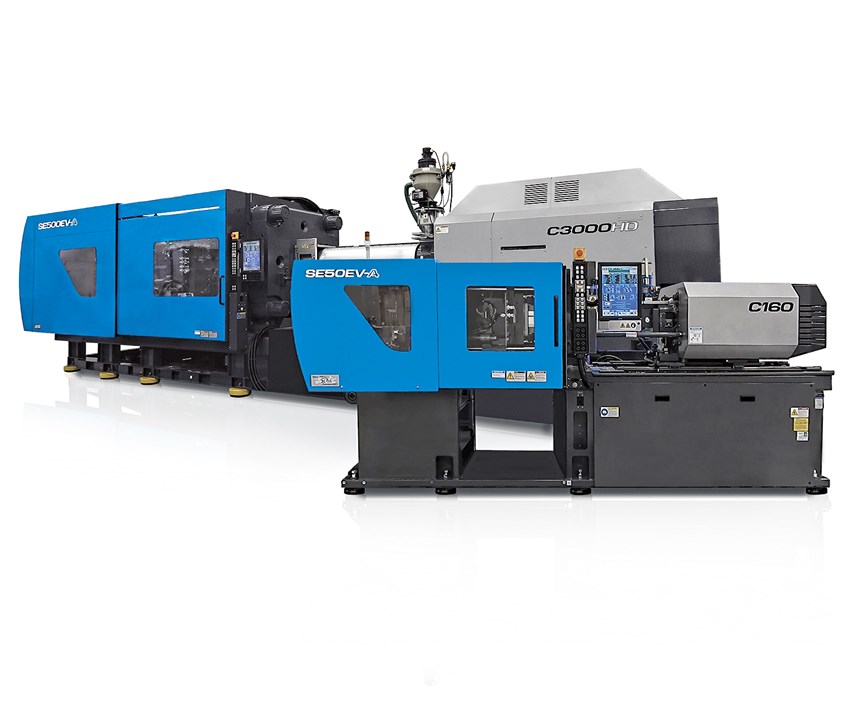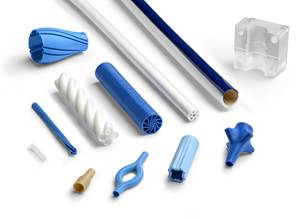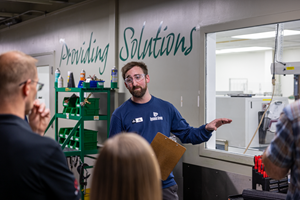Sumitomo’s Theme: Productivity + Flexibility + Reliability
Sumitomo Demag aims to demonstrate a combination of speed, flexibility, proprietary technologies, and automation with six machine cells running at NPE2018.
“Our theme for the show is ‘Productivity Plus.’ Why the ‘Plus’? Because it’s not enough for our machines to be fast—there are other factors our customers need for success,” says John F. Martich III, executive v.p. and COO of Sumitomo (SHI) Demag’s U.S. operations. Martich says the “Plus” factors include Flexibility, Technology, Automation, and Reliability.
Flexibility is a big one for Martich. It represents his machines’ capabilities for a broad range of molding tasks. “It’s rare today for a molder to serve just one market, like automotive, packaging, or consumer products. Because we have a broadly capable electric machine platform, and one control platform for all our machines, it makes it easier for those machines to serve a variety of markets.”
Sumitomo Demag makes this point by operating four machines from its SEEV-A all-electric line (out of six total) in its booth (W3045)—and six others at partner booths throughout the show—molding medical, automotive, packaging, and consumer-products applications. These machines span the full size range for that line, from 50 to 500 metric tons.
Another meaning of “flexibility” for Martich is the ability for Sumitomo Demag machines to handle higher cavitation, thinner walls, and tighter tolerances, especially when that means a smaller machine can take on a job that normally requires a larger press. “Take a long-flow automotive part that might normally run on a 600- or 700-ton machine. Thanks to our wider tiebar spacing and Minimum Clamping Molding (MCM) technology, that part can run on one of our 500-ton all-electric machines, and perhaps use only 300 tons of actual clamp force.”
Two more of Martich’s “Plus” factors are Technology and Automation. “We supply technology and automated cell solutions that can take molders to the next level,” he says. Examples at the show that he points out are an automotive part that is lightweighted with an unusual combination of gas assist and chemical foaming on a 500-ton SEEV-A press. That machine uses Sumitomo’s Flow Front Control technology to ensure consistent filling of long-flow parts, family molds, or other unbalanced tools.
Another specialized technology that the company is demonstrating is a fully automated, fast color-change process, including QC inspection, from Cam Co., Ltd., a Japanese molder and moldmaker. It is being used on a 50-ton SEEV-A press molding a small vacuum-cleaner fan blade.
“We’re also showing an automated cleanroom cell for producing a DNA-free medical sample collection tube. After the show, this machine will go to Makuta Inc. in Shelbyville, Ind., where it will run lights-out with “hands-off” inspection, QC, and packaging,” states Martich. That micromolding application uses a 30-ton SE-DUZ all-electric press.
Of course, if it’s naked speed you’re looking for, Sumitomo Demag has pulled out the stops with a 300-ton El-Exis hybrid press running 72 bottle caps in a 2-sec cycle. “That’s the real eye-opener at the booth,” enthuses Martich. But there’s more: a 180-ton SEEV-A press that’s injection-compression molding thin-wall lids in two cavities with IML in 4 sec; and a 130-tonner molding medical pipettes in 32 cavities in 7 sec.
An additional “Plus” factor is Reliability. “That’s a hard one to put into a few words,” muses Martich. “But take this example: A customer called me asking for additional operator training—or retraining—on a press they had been running for over a year. They told me that in all that time they had so little need to adjust any settings that the operators had simply forgotten how.”
By the way, the other booths where Sumitomo Demag SEEV-A machines are running are Yushin (W2173), RJG (W3383), Gammaflux (W643), and Canon Virginia (W223), which has three presses running.
Related Content
DuPont Buys Medical Product Manufacturer Spectrum Plastics
Purchase price of $1.75 billion for leading supplier of extruded, molded, and 3D printed medical components.
Read MoreUse Cavity Pressure Measurement to Simplify GMP-Compliant Medical Molding
Cavity-pressure monitoring describes precisely what’s taking place inside the mold, providing a transparent view of the conditions under which a part is created and ensuring conformance with GMP and ISO 13485 in medical injection molding.
Read MoreMedical Molder, Moldmaker Embraces Continuous Improvement
True to the adjective in its name, Dynamic Group has been characterized by constant change, activity and progress over its nearly five decades as a medical molder and moldmaker.
Read MoreMedical Manufacturer Innovates with Additive Manufacturing and Extrusion Technology Hubs
Spectrum Plastics Group offers customers two technology hubs — one for extrusion, the other for additive manufacturing — to help bring ground-breaking products to market faster.
Read MoreRead Next
Why (and What) You Need to Dry
Other than polyolefins, almost every other polymer exhibits some level of polarity and therefore can absorb a certain amount of moisture from the atmosphere. Here’s a look at some of these materials, and what needs to be done to dry them.
Read MoreHow Polymer Melts in Single-Screw Extruders
Understanding how polymer melts in a single-screw extruder could help you optimize your screw design to eliminate defect-causing solid polymer fragments.
Read MoreAdvanced Recycling: Beyond Pyrolysis
Consumer-product brand owners increasingly see advanced chemical recycling as a necessary complement to mechanical recycling if they are to meet ambitious goals for a circular economy in the next decade. Dozens of technology providers are developing new technologies to overcome the limitations of existing pyrolysis methods and to commercialize various alternative approaches to chemical recycling of plastics.
Read More




























